A Conversation About The Future Of eCommerce Payments

Ajay Kapur, CEO of Moovweb, a mobile optimization platform that is trying to solve the conundrum of shopping cart abandonment, recently sat down with PYMNTS at the eTail East summit in Boston to share his views on where he thinks the future of eCommerce payments is headed – and how it can help more merchants make sure that carts are checked out, instead of abandoned.
PYMNTS: So, in your opinion, where is the future of the payments industry headed, and will retailers ever be able to figure out the $4 trillion online cart abandonment issue?
AK: The next two years in the world of online payments is going to be unlike anything we have seen in the last 10 or so years.
PYMNTS: And why is that?
AK: Payments have always been thought of as just the exchange of money on the back end. Apple and Google are broadening the problem to the checkout user experience. When you think of Apple Pay in a web context, it should really be called Apple Checkout – fundamentally, they’re trying to streamline payment by wiping out that infuriatingly slow two-minute checkout process, and replacing it with a simple thumbprint. PayPal has been trying to do get top retailers to streamline checkout for the past five years, but they’ve failed. The only two companies that can do this are Apple and Google.
The first reason is because Apple has over 600 million customer accounts. Second, they own the browser, so you get an app-like experience, without forcing shoppers to install an app. Last, Apple in particular has the heft to bring together retailers and consumers in a way PayPal and others cannot.
For those reasons this shift to Thumbprint Checkout is inevitable. The reason it’s not talked about much today is only because it’s not live yet: these browsers aren’t updated until October, we estimate.
PYMNTS: And Moovweb recently announced a collaboration with Apple to optimize its platform for Apple Pay’s long-anticipated debut on mobile web. Can you tell us a little bit more about that partnership?
AK: With [Apple], it’s an informal collaboration to educate the market. The top 200 retailers move slow. Even if they believe it’s a win, the task of implementing this is a nontrivial matter. We’re able to go really deep with the retailers to get them live, and we do that through our product and through consulting services. And it’s either/or. Sometimes, retailers want both; sometimes, one or the other. We’ve become experts on the nuances of how to do this well.
PYMNTS: It seems as though there’s a lot of change going on right now in the payments industry and the checkout process. In a couple of years, how are people going to check out online and pay for things?
AK: Every product on the web is going to be as easy to buy as it is to buy on Amazon today. On Amazon, you never peck in your credit card information, shipping address, or contact information. You just decide what product you want, and buy it. Every single product on the web will be like that in, I’d say, 18–24 months.
PYMNTS: People will be paying for these things online through Apple Pay then? Android Pay? What?
AK: They’re not competitive in that Apple will dominate on Apple browsers, and Android will dominate on Chrome browsers. They may work to put their products on one another’s platforms, but we’ll see how that pans out.
PYMNTS: Do you see one of these payment methods being more successful than the other?
AK: Apple is on a mission where as Android is approaching it via open browser standards. They’re saying, “Hey, we’re going to make our browsers capable, and any payment option can work, including our own Android Pay.” But Apple Pay will work, as well.
Apple is being more aggressive about this. They seem to have far more invested in it – their teams are bigger and there appears to be more focus from their senior leadership.
At the same time, Google’s browser share is much higher, so it could easily become the norm, especially as the Chrome browser grows in popularity on iOS. Of the top 100 retailers, 15–20 of them will likely have it implemented by Black Friday. But in retail, everyone is a fast follower and we’re going to see a mass rollout of Thumbprint Checkout in 2017
In 18 to 24 months we’ll be in a world where forms are largely a thing of the past. Anything you want, can be purchased online with as little as a thumbprint and be delivered cheaply in a couple days. So checkouts are going to subsume what today we call online payments.
